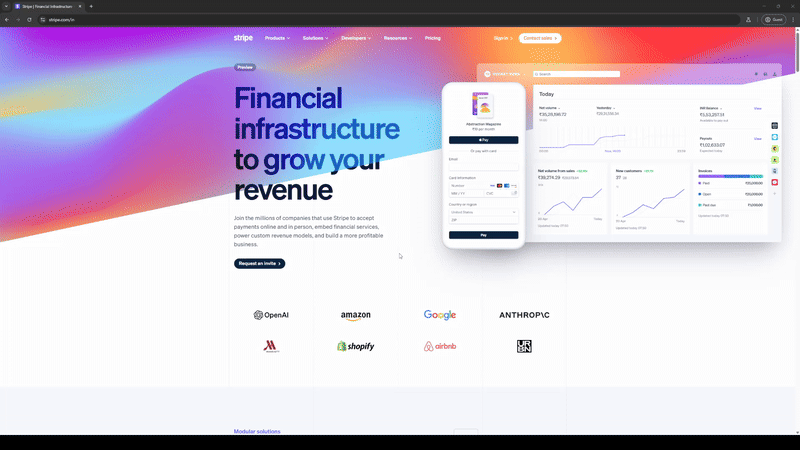The technology sector has evolved far beyond simple product demonstrations and feature lists. Today’s most compelling tech brands understand that visual storytelling serves as the bridge between complex innovation and human connection. When we examine standout tech brands like Apple, their success stems not from exhaustive technical specifications.
The success of such major tech brands come from their ability to weave product capabilities into brand narratives that resonate on an emotional level.
Visual storytelling in tech demands a delicate balance between simplification and sophistication.
The goal isn’t to strip away complexity entirely, but rather to present it in a way that creates immediate understanding while inviting deeper exploration.
Consider how Stripe transforms the intricacies of payment processing into elegant visual narratives. These stories speak to both technical decision-makers and business users through carefully crafted imagery and design. The idea is to help users visualize themselves using the product or service. If they can see themselves benefitting by using the service, then they automatically want to invest in it.

Inside this article,
Bridging the technical-visual divide
The challenge of technical storytelling lies in maintaining authenticity while creating broad appeal. Success requires developing a visual language that can scale from high-level concept introduction to detailed technical explanation without losing coherence or breaking brand consistency.
This visual system must serve multiple audiences simultaneously – technical experts who demand depth and accuracy, business decision-makers who need clear value propositions, and end users who seek solutions to their problems. Adobe exemplifies this approach in their marketing of creative software.
Their visual storytelling begins with aspirational imagery that captures the possibilities of creative work, then seamlessly transitions into detailed feature demonstrations that maintain the same aesthetic quality and emotional resonance. This creates a continuous narrative thread that serves both professional creators and aspirational users.
Also read: Why does brand storytelling matter?
How to create a visual language
A sophisticated visual language for tech brands extends far beyond the traditional elements of brand identity design. It encompasses how you visualize data, represent processes, demonstrate impact, and communicate complex relationships. This visual system must be robust enough to maintain consistency across diverse marketing channels while flexible enough to adapt to different content needs.
The most effective tech brand visuals tell stories at multiple levels simultaneously.
At first glance, they communicate a clear, immediate message. Upon closer inspection, they reveal layers of detail that reward deeper engagement.
Microsoft’s marketing uses this approach – their cloud infrastructure visualizations work both as immediate representations of connectivity and as detailed technical diagrams that IT professionals can study and understand.

The layered approach to visual storytelling delivers benefits that extend far beyond initial audience engagement. When visuals operate on multiple levels simultaneously, they create an efficiency in communication that serves diverse audience needs through a single asset.
Marketing teams can streamline their content production while still addressing the varying depths of technical understanding among their target audiences – from C-suite executives seeking high-level solutions to technical specialists requiring detailed specifications. This multi-layered approach also creates natural pathways for audience engagement, allowing viewers to self-select their level of interaction based on their needs and interests.
Trust and authenticity
Perhaps even more importantly, this stratified visual approach builds credibility and trust across audience segments. When technical audiences discover deeper layers of accurate, detailed information beneath an accessible surface, it validates the brand’s expertise and attention to detail.
Meanwhile, non-technical audiences aren’t overwhelmed by complexity but can still sense the underlying sophistication, which reinforces their confidence in the brand’s capabilities. This careful balance of accessibility and depth demonstrates respect for all audience segments while creating a unified brand narrative that scales seamlessly from initial awareness through to technical evaluation and implementation.
How can tech brands implement these ideas?
Successful visual storytelling in tech requires thinking beyond individual assets to create cohesive narrative ecosystems. This means developing visual frameworks that can support everything from social media content to detailed technical documentation while maintaining brand consistency and emotional resonance.
The implementation begins with understanding your brand’s core narrative – the fundamental story about how your technology impacts the world. This narrative then informs every visual choice, from the macro level of campaign design to the micro level of icon design and interface elements.
Consider how IBM has evolved its visual storytelling to support its quantum computing initiatives. Their approach combines abstract visualization of quantum concepts with concrete representations of real-world applications. This makes a visual narrative that makes cutting-edge technology feel both revolutionary and accessible.
How to measure the impact of visual marketing?
Effective visual storytelling in tech requires sophisticated measurement frameworks that go beyond traditional engagement metrics.
While quantitative measures like view counts and click-through rates matter, the true impact of visual brand storytelling manifests in qualitative changes in brand perception and understanding.
Success indicators include the sophistication of customer conversations about your technology.
It also includes the accuracy with which your audience can explain your solutions to others and the degree to which your visual language becomes referenced within your industry.
When NVIDIA discusses AI and machine learning, their visual frameworks often become the standard way that others in the industry represent these concepts.
Also read: Leveraging emotional intelligence in B2B marketing to transcend rationality
What is the future of visual brand storytelling in tech?
As technology continues to advance, the role of visual brand storytelling in tech marketing becomes increasingly crucial. The brands that succeed will be those that can create visual narratives that evolve with their technology while maintaining emotional resonance and clarity of purpose.
The future lies in creating visual stories that don’t just explain technology but invite audiences to see themselves as part of its evolution. This means developing visual languages that can grow and adapt while maintaining the core emotional truths that connect with audiences.
Visual storytelling in tech is ultimately about making the future feel present and possible. It’s about creating narratives that help audiences not just understand new technologies, but envision how these innovations will transform their world. When done effectively, it turns complex technical achievements into compelling stories of human progress and possibility.
Also read: Why does brand storytelling matter?




